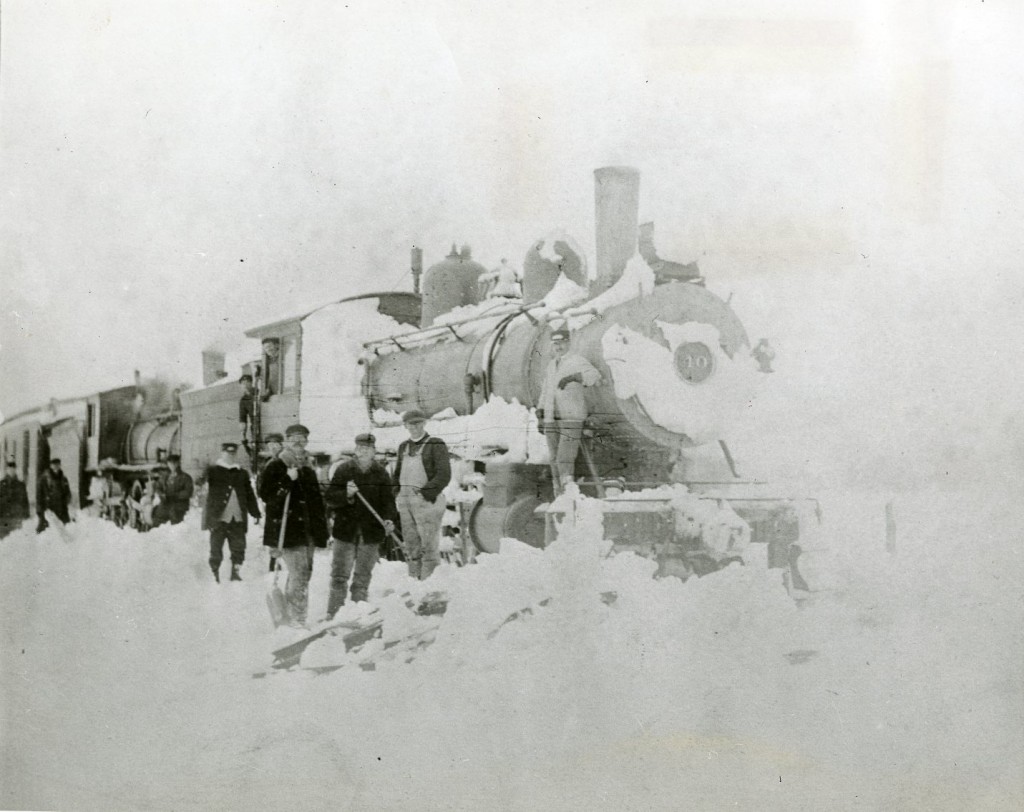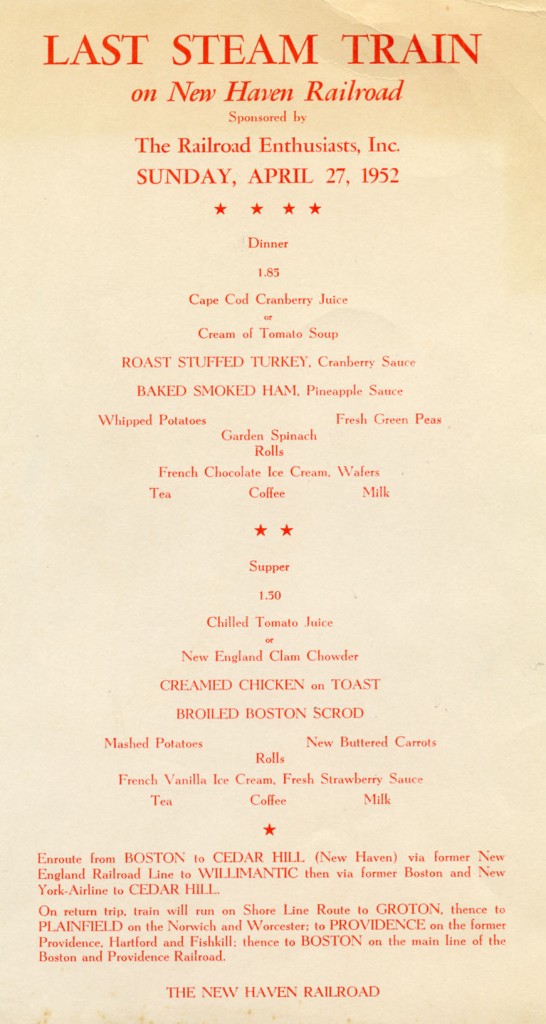We here in Archives & Special Collections are ready for whatever Mother Nature throws at us in the next couple of days! We’ll dig ourselves out of the snow just like these railroad workers from 1914.
Tag Archives: Locomotives
The Railroad of “Bankruptcy, Litigation, Fraud and Failure”
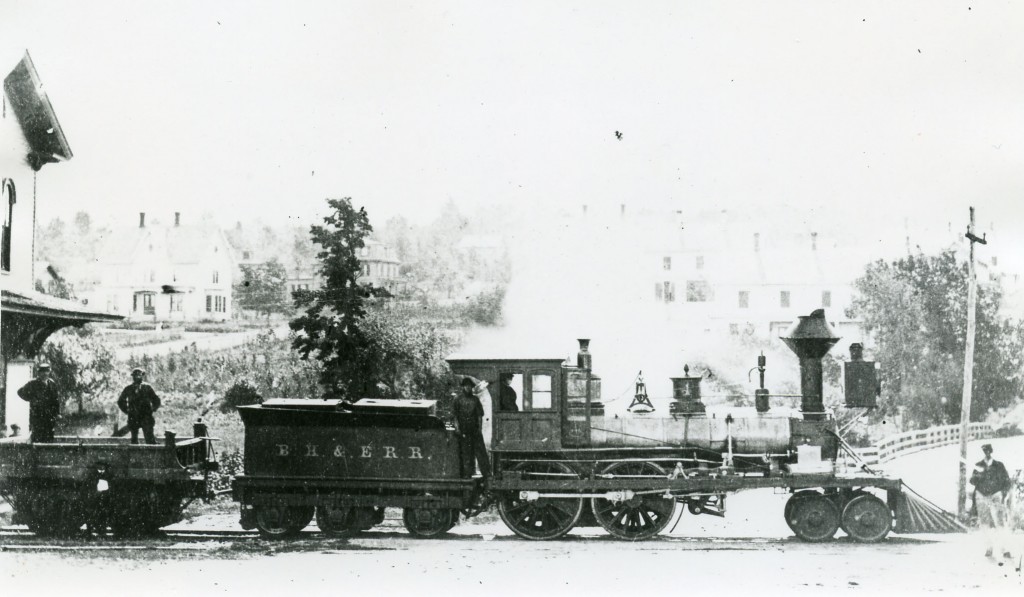
The “Hookset,” built in 1842 at the Hinkley & Drury Shops for the Concord Railroad. Was Locomotive #1 of the Boston, Hartford & Erie Railroad in 1863, then the New York & New England Railroad’s Locomotive #1 in 1871. From the Frances D. Donovan Papers, Archives & Special Collections, University of Connecticut Libraries.
One hundred and fifty years ago, in June 1863, the Boston, Hartford & Erie Railroad was incorporated with the goal of forming a gateway to western markets for New England goods and of bringing coal from Pennsylvania into New England by way of Newburgh, New York, to Waterbury, Connecticut, and beyond. Its lofty goal disintegrated when it came under the control of “as ribald a bunch of crooks as railroad history has ever produced,” wrote D.W. McLaughlin in his article “Poughkeepsie Gateway,” for the October 1968 issue of the Bulletin of the Railway & Locomotive Historical Society. The railroad ran into a myriad of troubles, including the realization that building an east-west route across Connecticut would involve navigating the state’s ridge lines, the problem of aligning with the non-standard gauge of track on the Erie Railroad (the western line it would hook up with once the railroad cars crossed the Hudson River), and the lack of a bridge for which to travel over the river. That apparently did not stop the railroad’s promoters from selling stock in the line, which they proceeded to mercilessly raid and pillage. The legislature of the state of Massachusetts was persuaded to give $3,000,000 in grants, odd in that the bulk of the railroad didn’t actually travel in that state, as it went into Connecticut. By the time the graft caught up with all the players, in 1870, the railroad was in bankruptcy with a mere $10.00 left in its accounts, Massachusetts was out all of the money it invested, and very little actual railroad track was ever laid. The remaining assets were transferred to the receivers of the New York & New England Railroad, who rerouted the railroad line from New York City to Boston and eventually became part of the New Haven Railroad system.
May 11 is National Train Day!
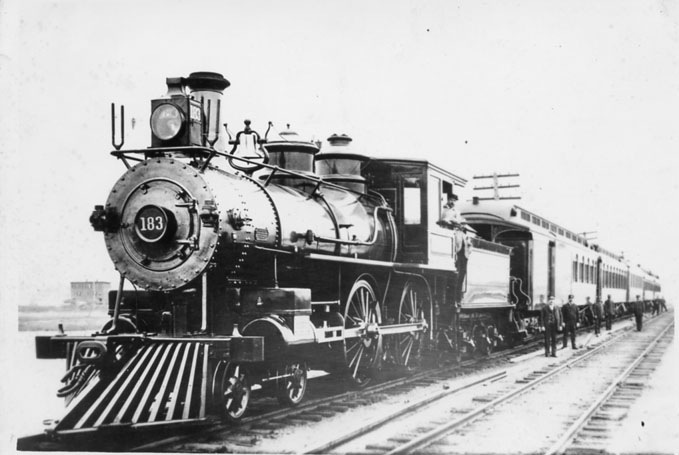
The New England Limited, better known as the White Train, or Ghost Train, which traveled from New York to Boston on the Air Line Division (formerly the Boston & New York Air Line Railroad) of the New York, New Haven & Hartford Railroad in the early 1890s. Leroy Roberts Railroad Collection, Archives & Special Collections, University of Connecticut Libraries.
Let’s get on board to celebrate National Train Day on Saturday, May 11! Amtrak organizes this event to celebrate the ways trains connect us all and to learn how trains are an instrumental part of our American story.
We here in the Railroad History Archive in Archives & Special Collections are celebrating this day by enjoying the rich resources in the collection that document how the railroad was pivotal to the lives of the people of New England in the Golden Age of Railroads in the late 1800s. This photograph shows the New England Limited on the Air Line Division, formerly the Boston & New York Air Line, which was built to provide a direct route diagonally across the state of Connecticut to connect the important financial centers of New York City and Boston. At the time this photograph was taken, in the 1890s, the B&NYAL was taken over by the New York, New Haven & Hartford Railroad and then known as the Air Line Division. The New England Limited reminds us of a time when luxurious trains were ridden by the Gilded Era’s captains of industry.
The Last Steam Trip on the New Haven Railroad, April 27, 1952
[slideshow_deploy id=’3736′]
In the early 1950s the New Haven Railroad phased out use of its steam fleet in favor of its electric and diesel locomotives. Shown here is a menu and photographs taken on an excursion trip from Boston’s South Station to New Haven, Connecticut, through the route of the old New York & New England Railroad with stops in Willimantic and New London, Connecticut. The photographs were taken by Seth P. Holcombe and Ralph E. Wadleigh, both of whose photographs we hold in the Railroad History Archives.
The end of the steam era in Connecticut — a new collection in the Railroad History Archives
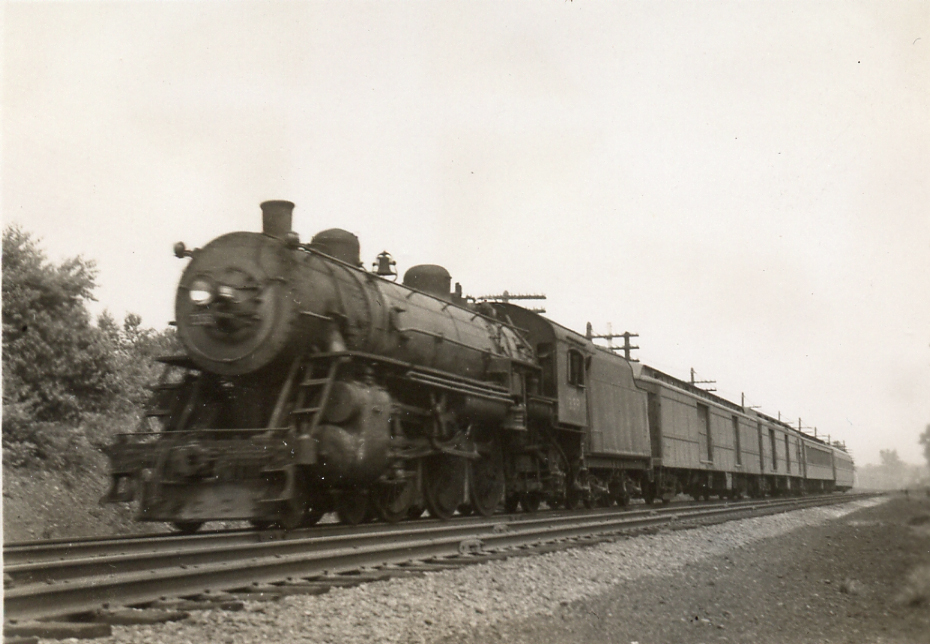
“The 12:25 to Waterbury.” Engine 1338 of the New Haven Railroad in Newington, Connecticut, on July 10, 1946. Photograph by Seth P. Holcombe.
Seth P. Holcombe loved steam trains, and as a youth who grew up near the railroad station in Hartford, Connecticut, he particularly admired those of the New York, New Haven & Hartford Railroad (better known as the New Haven Railroad), the predominant railroad in southern New England from 1872 to 1969. Mr. Holcombe was born in 1918 and lived his life in the Hartford area, graduating from Trinity College in 1941 and serving as registrar of the Morgan Horse Club (now known as the Connecticut Morgan Horse Association) as an adult. He was also an avid photographer and took numerous photographs of the trains he loved. His interest never wavered from the steam trains of the New Haven Railroad, so when the railroad switched to a diesel fleet in 1952 Mr. Holcombe’s interest in the railroad waned.
Seth Holcombe died in 2009 and his wife Lucy made a gracious gift of his photographs to the Railroad History Archive this year. The collection shows trains in and around Hartford, as well as other railroad lines across New England when Mr. Holcombe would travel on excursions. A finding aid to the collection is available at https://archivessearch.lib.uconn.edu/repositories/2/resources/908 and all are welcome to come to Archives & Special Collections to view this terrific set of photographs.
More “Men and their Magnificent Machines”
June 2011 Item of the Month: Railroad Men and their Magnificent Machines
Charles Dickens, in his 1842 book American Notes, wrote about an excursion he took by train from Boston to Lowell, Massachusetts. He describes his trip in this way: “[The train] whirls headlong…clatters over frail arches, rumbles upon the heavy ground, shoots beneath a wooden bridge which intercepts the light for a second like a wink, suddenly awakens all the slumbering echoes in the main street of a large town, and dashes on haphazard, pell-mell, neck-or-nothing, down the middle of the road…there – on, on, on – tears the mad dragon of an engine with its train of cars; scattering in all directions a shower of burning sparks from its wood fire, screeching, hissing, yelling, panting; until at last the thirsty monster stops beneath a covered way to drink, the people cluster round, and you have time to breathe again.”
Takes your breath away, doesn’t it?
Railroads came on the scene in the United States in the early 1830s and immediately took hold of the national psyche, changing concepts of speed and time and providing limitless possibilities of the movement of agricultural products, goods of industry, and people to all points across the country. The railroad was the means that brought the Industrial Revolution to the United States, ushering in the modern world we know today. To the people of the 19th century, the railroad was a dream, a miracle, a danger, and the most marvelous thing they had ever seen.
The Railroad History Archive has many thousands of photographs. Most focus on locomotives and scenes of the New Haven Railroad, the predominant railroad line in southern New England from 1872 to 1968. We have photographs of railroad stations and other structures, railroad yards, passenger cars and dining cars. We have photographs of railroad bridges, railroad tunnels, and railroad trestles.
But few photographs are as evocative as the one above, where railroad men pose with the nation’s new obsession.

